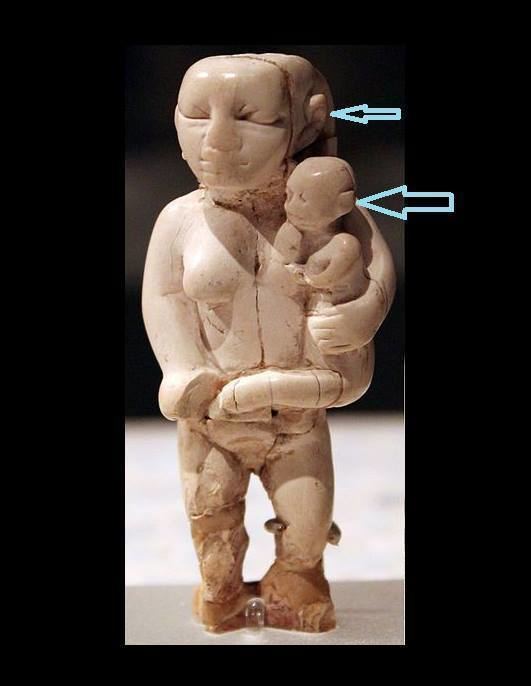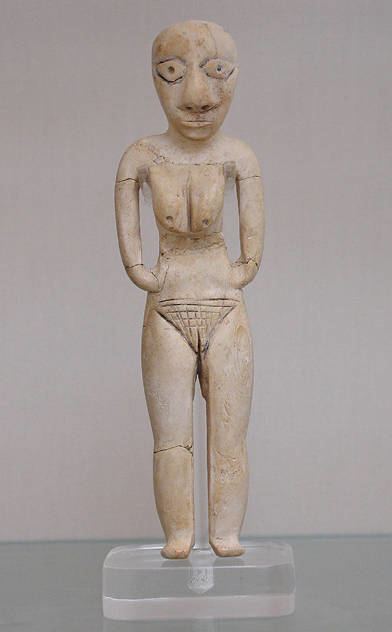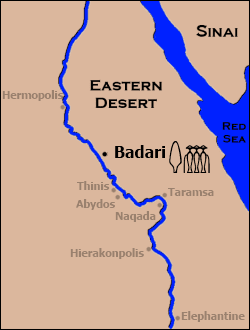Geographical range Egypt Preceded by Faiyum A culture | Type site El-Badari | |
 | ||
Dates circa 5,000 B.C.E. — circa 4,000 B.C.E. | ||
Badari culture
The Badarian culture provides the earliest direct evidence of agriculture in Upper Egypt during the Predynastic Era. It flourished between 4400 and 4000 BCE, and might have already emerged by 5000 BCE. It was first identified in El-Badari, Asyut Governorate.
Contents
About forty settlements and six hundred graves have been located. Social stratification has been inferred from the burying of more prosperous members of the community in a different part of the cemetery. The Badarian economy was based mostly on agriculture, fishing and animal husbandry. Tools included end-scrapers, perforators, axes, bifacial sickles and concave-base arrowheads. Remains of cattle, dogs and sheep were found in the cemeteries. Wheat, barley, lentils and tubers were consumed.

The culture is known largely from cemeteries in the low desert. The deceased were placed on mats and buried in pits with their heads usually laid to the South, looking West. This seems contiguous with the later dynastic traditions regarding the West as the land of the dead. The pottery that was buried with them is the most characteristic element of the Badarian culture. It had been given a distinctive, decorative rippled surface.

Location and discovery

Badari culture is so named because of its discovery at El-Badari (Arabic: البداري), an area in the Asyut Governorate in Upper Egypt. It is located between Matmar and Qau, approximately 200 km northwest of present-day Luxor (ancient Thebes). El-Badari includes numerous Predynastic cemeteries (notably Mostagedda, Deir Tasa and the cemetery of el-Badari itself), as well as at least one early Predynastic settlement at Hammamia. The area stretches for 30 km along the east bank of the Nile, was first excavated by Guy Brunton and Gertrude Caton-Thompson between 1922 and 1931. Most of the local cemeteries have yielded distinctive pottery vessels (particularly red-polished ware with blackened tops), as well as terracotta and ivory anthropomorphic figures, slate palettes, stone vases and flint tools. The contents of Predynastic cemeteries at el-Badari have been subjected to a number of analyses attempting to clarify the chronology and social history of the Badarian period.
Cultural features
Populations in the Badari culture planted wheat and barley, and kept cattle, sheep, and goats. They fished from the Nile and hunted gazelle. Little is known of their buildings, although remains of wooden stumps have been found at one site and may have been associated with a hut or shelter of unknown construction. Pits that have been found may have served as granaries. Some Badarian sites also show evidence of later predynastic use.

Badarian grave goods were relatively simple and the deceased wrapped in reed matting or animal skins and placed with personal items such as shell or stone beads. Green malachite ore, perhaps for personal decoration, has also been detected on stone palettes.
Trade

Basalt vases found at Badari sites were most likely traded up the river from the Delta region or from the northwest. Shells came in quantities from the Red Sea. Turquoise possibly came from Sinai; copper from the North. A Syrian connection is suggested for a four-handled pot of hard pink ware. The black pottery, with white incised designs, may have come directly from the West, or from the South. The porphyry slabs are like the later ones in Nubia, but the material could have come from the Red Sea mountains. The glazed steatite beads were not made locally. These all suggest the Badarians were not an isolated tribe, but were in contact with the cultures on all sides of them. Nor were they nomadic, having pots of such size and fragility that would have been unsuitable for use by wanderers.
Ancestral origins
The Badarian culture seems to have had multiple sources, of which the Western Desert was probably the most influential. Badari culture was likely not to have been solely restricted to the Badari region since related finds have been made farther to the south at Mahgar Dendera, Armant, Elkab and Nekhen (named Hierakonpolis by the Greeks), as well as to the east in the Wadi Hammamat.
